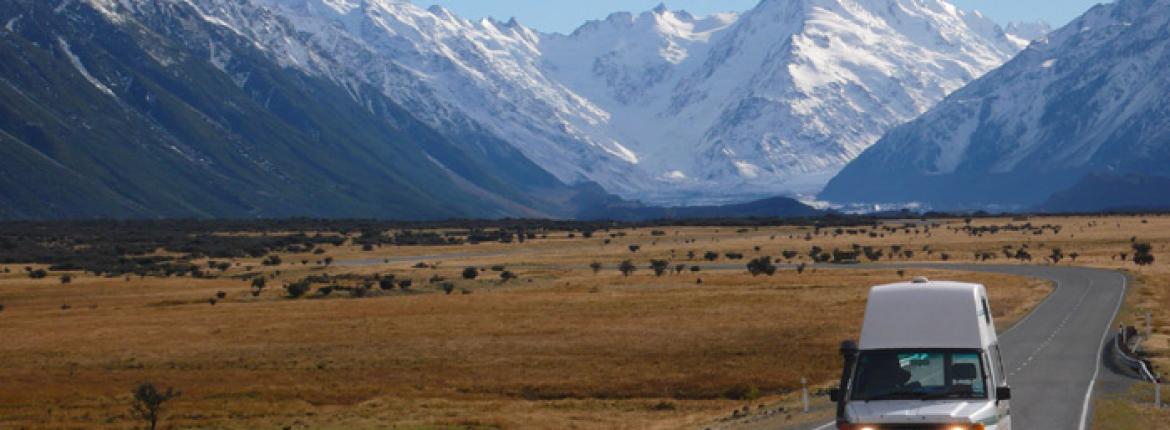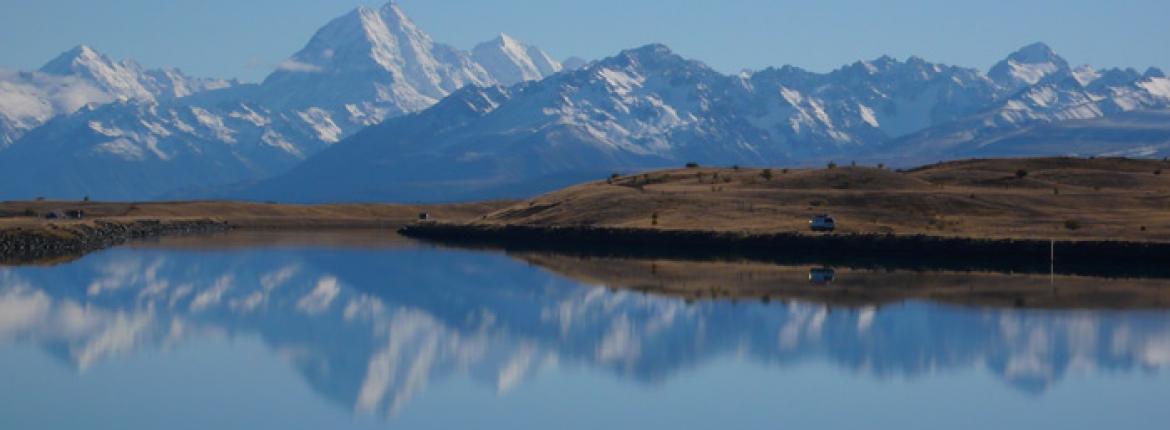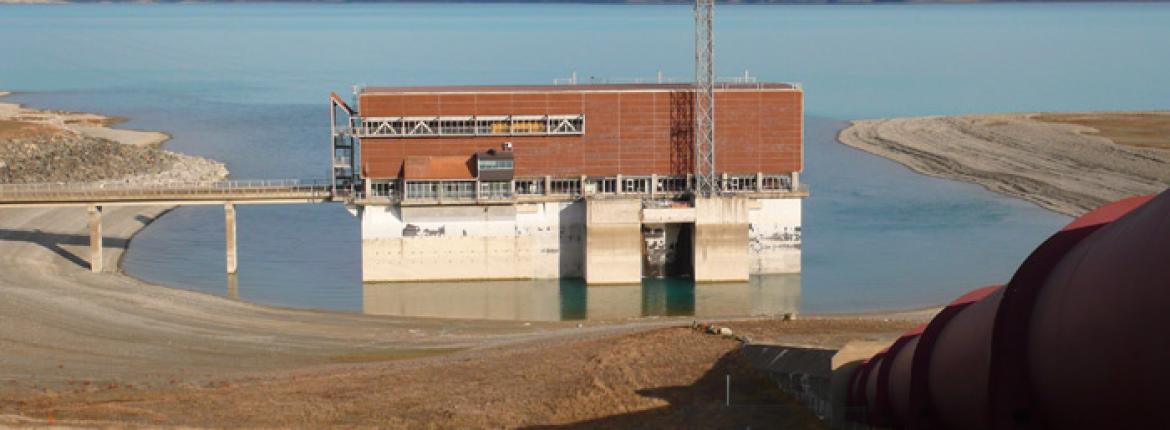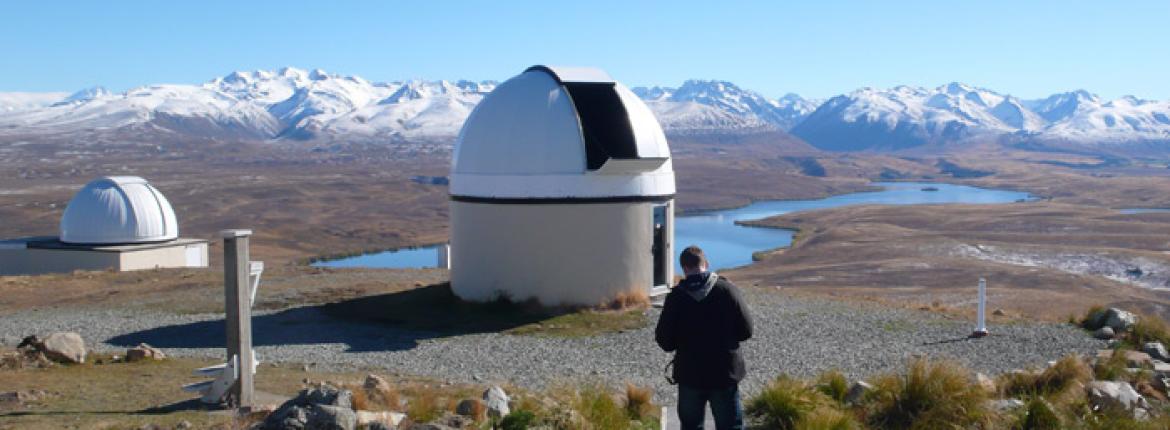The sinuous road, on which so many car advertisements have been filmed, cuts down through the straight lines of river terraces and around the curves of the hills, snaking through the tussock that covers everything like a sea of gold, until at the bottom it bursts out onto a vast open plain. The Mackenzie country.
The first thing you notice, after the glittering horizon of the Alps, is the sky: vast, uncluttered and uncommonly clear. This sky is quickly becoming one of the Mackenzie’s precious assets but the land below is just as sparse, open and inviting. For its discoverer, loveable rogue and sheep rustler James Mackenzie, it was a good place to disappear and it is still so today. For solitude in an inspired setting, I know of no better place than the hidden nooks and corners of the Mackenzie.
This time it was a long weekend as I drove down the Lindis and it was apparent that many of my fellow travellers were eager to disappear into Mackenzie with a degree of haste. The district’s sleek highways tend to induce heavy-footed driving in some people and though my bushcamper was humming at a steady hundred, strings of cars, some towing boats, were overtaking us as though we were not moving at all.
Near Twizel, a Police patrol car was a silent witness to the weekend race, its speed camera running hot.
Like Tekapo, Mackenzie’s other main centre, Twizel was once a works camp accommodating the construction crews for the Waitaki hydro scheme. It was a 50-year-long earthworks project, pharaonic in its scope, which resulted in eight dams and a network of elevated aqueducts, some of which cross over rivers in split-level intersections.
Also like Tekapo, Twizel was to be bulldozed once the construction was over, but many of the redundant workers chose to stay on. Properties were cheap, excellent amenities were already in place and what better than to wake up to the sight of sunrise on the flanks of Mt Cook?
There is no escaping the towering presence of our highest mountain wherever you are in the Mackenzie. Its white bulk is a feature dominating the sepia-brown desert landscape from any angle. It’s a big mountain by all standards. In April 1860, after seeing it for the first time Samuel Butler wrote: “No one can mistake it. If a person says he thinks he has seen Mount Cook, you may be quite sure he has not seen it. The moment it comes into sight the exclamation is, ‘This is Mount Cook’ – not ‘That must be Mount Cook!’” I’d often come to Mt Cook to climb and to ski but this was my first visit since the Sir Edmund Hillary Alpine Centre opened adjacent to the Hermitage Hotel. Sir Ed had a long association with Mt Cook. He was the first to climb the South Ridge, the distinctive right-hand edge of the pyramid profile seen from the village. With Mt Cook rising as high as it does above the valley floor, this was
I’d often come to Mt Cook to climb and to ski but this was my first visit since the Sir Edmund Hillary Alpine Centre opened adjacent to the Hermitage Hotel. Sir Ed had a long association with Mt Cook. He was the first to climb the South Ridge, the distinctive right-hand edge of the pyramid profile seen from the village. With Mt Cook rising as high as it does above the valley floor, this was
a sort of dry run on the home ground before venturing to knock the big bastard off. Even today the climb up the South Ridge remains a major and not often repeated undertaking.
It seems only fitting that under our highest peak there should be a memorial to the ‘mountain of a man’. But although it displays an impressive range of Hillary memorabilia, including the Ferguson tractor which Sir Ed converted into an Antarctic skidoo, the centre is more than just a museum of mountaineering and a tribute to the great man. It also features a 3D movie, a full-dome planetarium with shows like Black Holes and Grand Tour of the Universe, and nightly star-gazing tours.
This astro-tourism is one of the Mackenzie’s hottest new activities but to go to the source of it all you need to travel to Lake Tekapo and take a winding narrow lane to the observatory at the top of Mt John.
Up here, on a clear crisp night, with an absence of any light pollution from distant towns or cities, the stars are so sharp, clear and numerous they seem almost fake, like a background for a George Lucas movie.
So unique and outstanding is the quality of the night sky here that a group of Tekapo locals are seeking to protect it under the auspices of UNESCO.  “The World Heritage List includes locations which are of such universal value, they are considered the heritage of all humankind,” Graeme Murray, one of the idea’s instigators told me. “They are the natural wonders like the Great Barrier Reef, Kakadu or Serengeti, and places of the highest cultural significance: the pyramids of Giza, the Great Wall of China, Taj Mahal and Vatican City. In New Zealand we have three such sites: Te Wahipounamu, Tongariro and the Sub-Antarctic Islands. Now we want to add a fourth one: the sky above Mackenzie Country.”
“The World Heritage List includes locations which are of such universal value, they are considered the heritage of all humankind,” Graeme Murray, one of the idea’s instigators told me. “They are the natural wonders like the Great Barrier Reef, Kakadu or Serengeti, and places of the highest cultural significance: the pyramids of Giza, the Great Wall of China, Taj Mahal and Vatican City. In New Zealand we have three such sites: Te Wahipounamu, Tongariro and the Sub-Antarctic Islands. Now we want to add a fourth one: the sky above Mackenzie Country.”
If successful, Lake Tekapo would become the pilot study for a brand-new heritage category, Earth’s first Starlight Reserve, a World Heritage Park in the sky. Why protect the sky, you wonder? “We’ve lost the starlight in so many places, our kids grow up without ever knowing what the Southern Cross looks like and where to find it,” amateur astronomer Grant Bisset told me at Mt John. “Without seeing the stars, how can we know our time and place in the Universe?”
That night, as we camped on the shore of Lake Pukaki, the Southern Cross was etched up above and so was Orion and countless other constellations. I remembered how, in the Australian outback, an Aborigine elder once told me that according to their mythology the night stars were the campfires of the ancestors. From driftwood and abundant pine cones I made my own little fire to feel more a part of that ethereal tribe. The lake was mirror-still and beyond it the mass of Mt Cook, ghostly-white in the starlight, stood like some fairytale ice castle. I thought of Bisset’s “our time and place in the Universe.” Mine was certainly here and now.
Reported by Derek Grzelewski for our AA Directions Autumn 2011 issue







